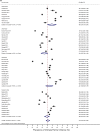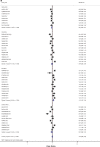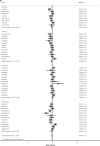Effects of rural-urban residence and education on intimate partner violence among women in Sub-Saharan Africa: a meta-analysis of health survey data
- PMID: 33849492
- PMCID: PMC8045348
- DOI: 10.1186/s12905-021-01286-5
Effects of rural-urban residence and education on intimate partner violence among women in Sub-Saharan Africa: a meta-analysis of health survey data
Abstract
Background: Intimate Partner Violence (IPV) against women is a major public health and human rights problem worldwide. Sub-Saharan Africa (SSA) has one of the highest prevalence of IPV against women in the world. This study used meta-analysis to obtain pooled rural-urban and education attainment differences in the prevalence of IPV among ever-partnered women in SSA, and assessed whether the differences in IPV depended on the SSA region or period or women's age.
Methods: We analysed IPV data on 233,585 ever-partnered women aged 15-49 years from 44 demographic and health surveys conducted between 2000 and 2018 in 29 SSA countries. Random-effects meta-analyses were used to estimate overall rural-urban residence and educational differences in IPV rates among the women in SSA. Subgroup analyses were also done to investigate the sources of heterogeneity in the overall meta-analysis findings.
Results: The pooled prevalence of intimate partner violence was estimated to be 41.3% (37.4-45.2%). Regionally, the highest prevalence of IPV was in Middle Africa (49. 3%; 40.32-58.45), followed by East Africa (44.13%; 36.62-51.67), Southern Africa (39.36%; 34.23-44.49), and West Africa (34.30%; 27.38-41.22). The risks of experiencing IPV were significantly higher if the women had less than secondary education (RR = 1.12; 95% CI 1.07-1.22) compared to those with at least a secondary education. Generally, women who resided in a rural area had their risks of experiencing IPV increased (RR = 1.02; CI 0.96-1.06) compared to those who resided in urban areas, but the IPV increases were only significant in East Africa (RR = 1.13; CI 1.07-1.22).
Conclusion: In sub-Saharan Africa, intimate partner violence against women is widespread, but the levels are much higher among women with lower levels of education and residing in rural areas. Our findings have provided additional support to policies aimed at achieving SDG goals on the elimination of all forms of violence against women and girls in sub-Saharan Africa. For example, policies that advocate improved educational attainment, especially among women and communities in rural areas.
Keywords: Education level difference; Intimate partner violence; Meta-analysis; Residence differences; Sub-Saharan Africa.
Conflict of interest statement
The authors declare that they have no competing interests.
Figures












Similar articles
-
Correlates of intimate partner violence among urban women in sub-Saharan Africa.PLoS One. 2020 Mar 25;15(3):e0230508. doi: 10.1371/journal.pone.0230508. eCollection 2020. PLoS One. 2020. PMID: 32210457 Free PMC article.
-
Is intimate partner violence vertically transmitted among women in sub-Saharan Africa? Evidence from demographic health surveys between 2010 and 2019.Int J Equity Health. 2023 Dec 15;22(1):262. doi: 10.1186/s12939-023-02074-3. Int J Equity Health. 2023. PMID: 38102618 Free PMC article.
-
Intimate partner violence against married and cohabiting women in sub-Saharan Africa: does sexual autonomy matter?Reprod Health. 2022 Mar 28;19(1):79. doi: 10.1186/s12978-022-01382-1. Reprod Health. 2022. PMID: 35346246 Free PMC article.
-
Intimate Partner Violence (IPV) Against HIV-Positive Women in Sub-Saharan Africa: A Mixed-Method Systematic Review and Meta-Analysis.Trauma Violence Abuse. 2021 Dec;22(5):1104-1128. doi: 10.1177/1524838020906560. Epub 2020 Feb 18. Trauma Violence Abuse. 2021. PMID: 32067599
-
Gender Based Violence against Women in Sub-Saharan Africa: A Systematic Review and Meta-Analysis of Cross-Sectional Studies.Int J Environ Res Public Health. 2020 Feb 1;17(3):903. doi: 10.3390/ijerph17030903. Int J Environ Res Public Health. 2020. PMID: 32024080 Free PMC article.
Cited by
-
The significance of feeling safe for resilience of adolescents in sub-Saharan Africa.Front Psychol. 2023 Aug 17;14:1183748. doi: 10.3389/fpsyg.2023.1183748. eCollection 2023. Front Psychol. 2023. PMID: 37663363 Free PMC article.
-
Men's education and intimate partner violence-Beyond the victim-oriented perspective: Evidence from demographic and health surveys in Central Africa.PLoS One. 2024 Apr 25;19(4):e0302627. doi: 10.1371/journal.pone.0302627. eCollection 2024. PLoS One. 2024. PMID: 38662749 Free PMC article.
-
Intimate partner violence, behaviours associated with risk of HIV acquisition and condom use in married women in Manicaland, East Zimbabwe: An HIV prevention cascade analysis.BMC Womens Health. 2024 Nov 6;24(1):592. doi: 10.1186/s12905-024-03428-x. BMC Womens Health. 2024. PMID: 39506715 Free PMC article.
-
Toward Ending Violence Against Women: The Association of Intimate Partner Violence With Food Security Status Among Ever-Married Women in Cameroon.J Interpers Violence. 2025 Feb;40(3-4):955-973. doi: 10.1177/08862605241255731. Epub 2024 May 29. J Interpers Violence. 2025. PMID: 38808963 Free PMC article.
-
Intimate partner violence among Nepalese women and associated factors in 2021-2022.PLOS Glob Public Health. 2025 Mar 25;5(3):e0003267. doi: 10.1371/journal.pgph.0003267. eCollection 2025. PLOS Glob Public Health. 2025. PMID: 40131998 Free PMC article.
References
-
- McCloskey LA, Boonzaier F, Steinbrenner SY, Hunter T. Determinants of intimate partner violence in sub-Saharan Africa: a review of prevention and intervention programs. Partn Abus. 2016;7(3):277–315. doi: 10.1891/1946-6560.7.3.277. - DOI
-
- García-Moreno C, Pallitto C, Devries K, Stöckl H, Watts C, Abrahams N. Global and regional estimates of violence against women. Geneva: World Health Organization; 2013.
Publication types
MeSH terms
LinkOut - more resources
Full Text Sources
Other Literature Sources
Medical
Research Materials

